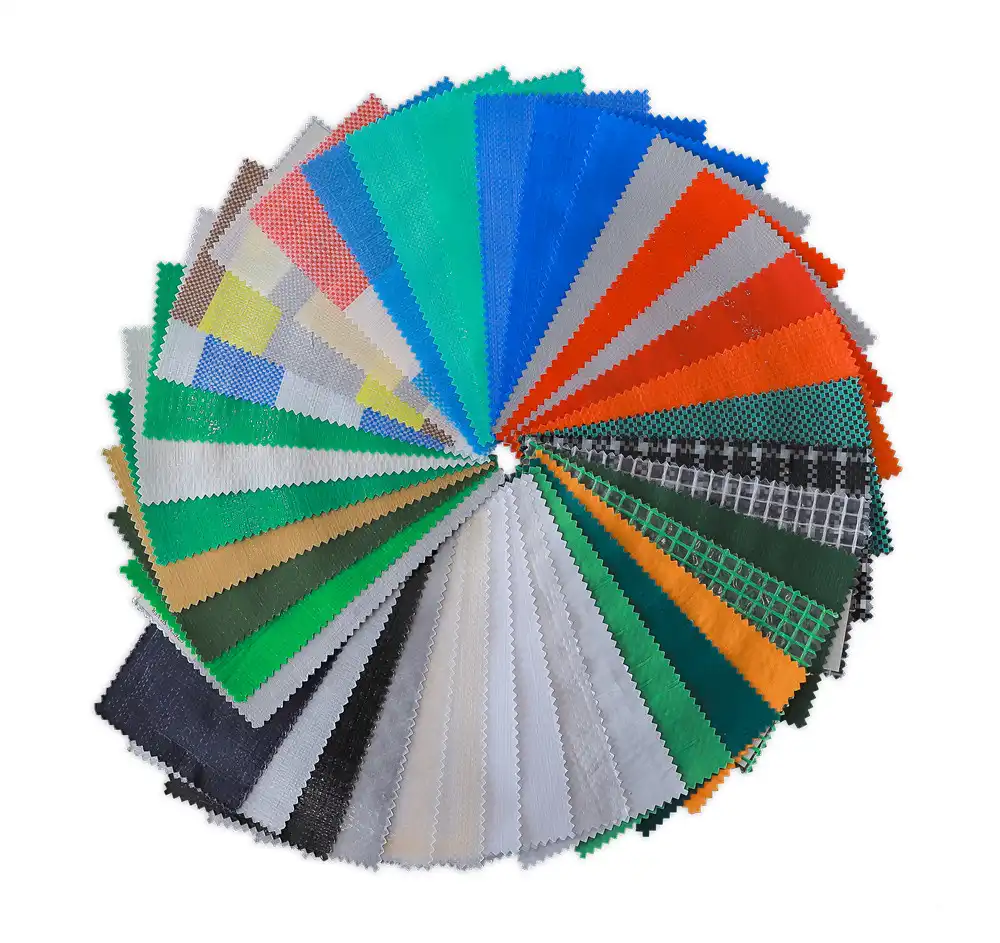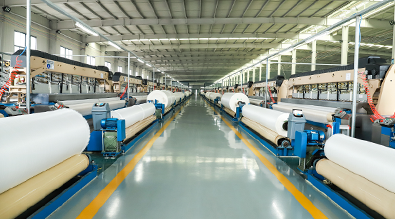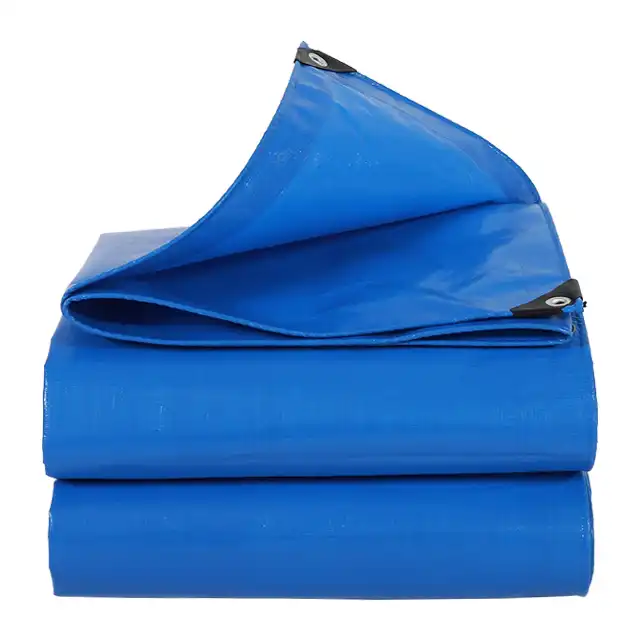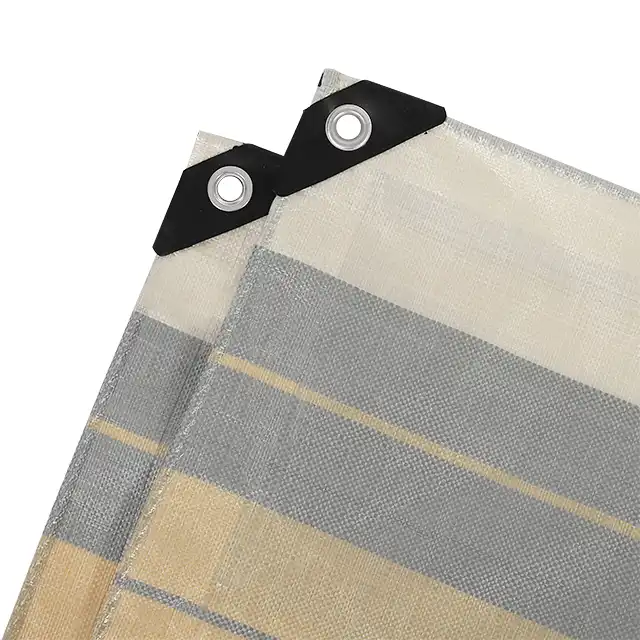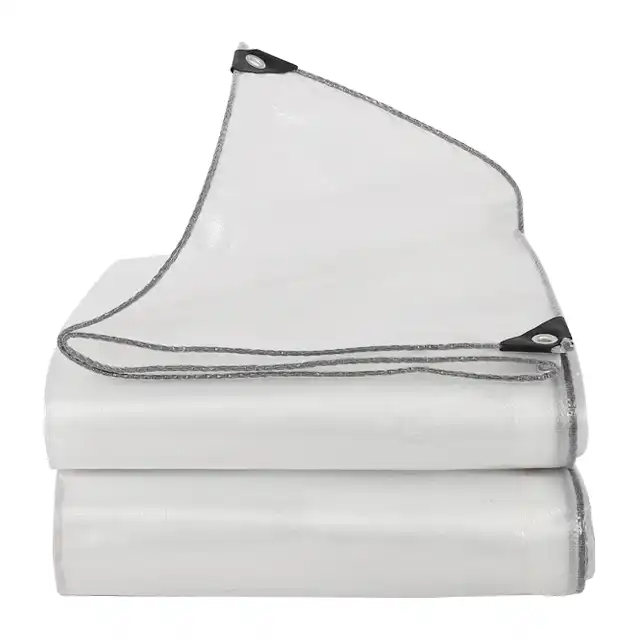How Long Can a Roof Tarp Last in Extreme Weather?
When disaster strikes your roof, one of the most critical questions homeowners face is understanding the longevity of temporary roof protection. Roof tarps can last anywhere from 90 days to 2 years depending on material quality, weather conditions, and proper installation. Weatherproof tarps designed for extreme conditions provide essential protection during emergency situations, serving as a crucial barrier between your home and the elements while permanent repairs are arranged. The durability of these protective covers depends on various factors including material composition, installation quality, and the severity of weather exposure they must endure.
Key Factors That Determine Roof Tarp Longevity in Harsh Conditions
Material Quality and Composition Standards
 The foundation of any durable roof tarp lies in its material composition and manufacturing quality. Professional-grade weatherproof tarps constructed from high-density polyethylene (HDPE) with specialized coatings offer superior protection compared to standard residential tarps. Premium tarps feature multi-layered construction with HDPE woven fabric cores and LDPE coating applications, providing exceptional tear resistance and waterproofing capabilities. These advanced materials undergo rigorous testing to ensure they can withstand temperature fluctuations ranging from arctic conditions to extreme heat, making them ideal for long-term roof protection applications. The weight specification of weatherproof tarps directly correlates with their durability in extreme weather conditions. Professional-grade tarps typically range from 100gsm to 280gsm, with heavier variants offering enhanced protection against wind uplift, puncture damage, and UV degradation. Higher-quality materials like vinyl typically offer greater durability than less expensive options like polyethylene, with vinyl tarps withstanding harsh conditions and lasting several years even in extreme heat, heavy rain, or snow. The mesh count specifications, ranging from 10x10 to 14x14, determine the fabric's structural integrity and resistance to tearing under stress. The manufacturing process incorporating UV treatment percentages between 1% to 7% ensures that weatherproof tarps maintain their structural integrity when exposed to prolonged sunlight. Advanced coating technologies create multi-layer protection systems that prevent moisture penetration while allowing controlled breathability to prevent condensation buildup underneath the tarp. These technical specifications directly impact the tarp's ability to maintain protective qualities throughout extended exposure periods in challenging weather conditions.
The foundation of any durable roof tarp lies in its material composition and manufacturing quality. Professional-grade weatherproof tarps constructed from high-density polyethylene (HDPE) with specialized coatings offer superior protection compared to standard residential tarps. Premium tarps feature multi-layered construction with HDPE woven fabric cores and LDPE coating applications, providing exceptional tear resistance and waterproofing capabilities. These advanced materials undergo rigorous testing to ensure they can withstand temperature fluctuations ranging from arctic conditions to extreme heat, making them ideal for long-term roof protection applications. The weight specification of weatherproof tarps directly correlates with their durability in extreme weather conditions. Professional-grade tarps typically range from 100gsm to 280gsm, with heavier variants offering enhanced protection against wind uplift, puncture damage, and UV degradation. Higher-quality materials like vinyl typically offer greater durability than less expensive options like polyethylene, with vinyl tarps withstanding harsh conditions and lasting several years even in extreme heat, heavy rain, or snow. The mesh count specifications, ranging from 10x10 to 14x14, determine the fabric's structural integrity and resistance to tearing under stress. The manufacturing process incorporating UV treatment percentages between 1% to 7% ensures that weatherproof tarps maintain their structural integrity when exposed to prolonged sunlight. Advanced coating technologies create multi-layer protection systems that prevent moisture penetration while allowing controlled breathability to prevent condensation buildup underneath the tarp. These technical specifications directly impact the tarp's ability to maintain protective qualities throughout extended exposure periods in challenging weather conditions.
Environmental Impact Assessment
Weather severity plays the most significant role in determining how long roof tarps can effectively protect structures. Extreme temperature fluctuations cause expansion and contraction cycles that stress tarp materials, potentially leading to micro-tears and reduced waterproofing effectiveness over time. High winds create uplift forces that test the strength of both the tarp material and its securing mechanisms, with sustained winds over 40 mph posing particular challenges to tarp integrity. The duration can vary based on the severity of weather conditions and the quality of tarp installation, making environmental assessment crucial for predicting tarp lifespan. Heavy precipitation events, including rain, sleet, and snow accumulation, create additional stress on weatherproof tarps through weight loading and constant moisture exposure. Professional-grade tarps must demonstrate complete waterproof capabilities while maintaining flexibility in freezing conditions to prevent brittle failure. The arctic flexibility feature ensures that tarps remain pliable and tear-resistant even when temperatures drop significantly below freezing, maintaining their protective barrier function throughout winter months. UV radiation exposure represents another critical environmental factor affecting tarp longevity. Extended exposure to direct sunlight breaks down polymer chains in tarp materials, leading to brittleness and eventual failure. Quality weatherproof tarps incorporate specialized UV inhibitors and reflective coatings that significantly extend their operational lifespan in high-radiation environments. These protective measures can extend tarp life from months to years, depending on the intensity and duration of UV exposure in specific geographical locations.
Professional Installation Requirements
Proper installation techniques significantly influence how long weatherproof tarps can effectively protect roofs in extreme weather conditions. Professional installation ensures that tarps are positioned with appropriate overlap margins, typically extending at least 4 feet beyond damaged areas on all sides to prevent water infiltration. Securing methods must account for local wind loading requirements, with proper fastening intervals and reinforcement points strategically placed to distribute stress evenly across the tarp surface. The selection of appropriate fastening hardware directly impacts tarp longevity under extreme conditions. Professional installations utilize specialized screws with neoprene washers, creating watertight seals that prevent both water infiltration and fastener pull-through under high wind conditions. Strategic placement of additional reinforcement strips at stress concentration points helps distribute loads and prevents tear propagation from fastener locations during severe weather events. Proper drainage considerations during installation prevent water pooling that can create excessive weight loads and stress concentrations. Professional installers create slight slopes and incorporate drainage channels that direct water away from critical areas while maintaining the tarp's protective coverage. These installation refinements can significantly extend tarp life by reducing stress concentrations and preventing premature failure modes that commonly occur with improper installation techniques.
Material Performance Analysis Under Severe Weather Conditions
Heavy-Duty Polyethylene Construction Benefits
Modern weatherproof tarps manufactured from high-density polyethylene demonstrate exceptional performance characteristics under severe weather conditions. The tightly woven fabric structure provides superior tear resistance while maintaining flexibility across wide temperature ranges. Professional-grade PE tarps feature laminated construction with protective coatings applied to both surfaces, creating multiple barriers against moisture penetration and environmental degradation. This multi-layer approach ensures that even if the outer coating experiences minor damage, the underlying fabric structure continues to provide effective protection. The molecular structure of high-quality polyethylene materials provides inherent resistance to chemical degradation from acid rain, industrial pollutants, and other environmental contaminants that can compromise lesser materials. Advanced manufacturing processes create uniform density distributions throughout the fabric, eliminating weak points that could lead to premature failure under stress. These construction advantages enable premium weatherproof tarps to maintain their protective qualities for extended periods, often exceeding manufacturer specifications when properly installed and maintained. Tear resistance capabilities of professional-grade PE tarps significantly exceed standard residential products, with reinforced edge construction and strategically placed stress distribution features. The incorporation of high-strength yarns provides additional reinforcement at critical stress points, preventing tear propagation that could compromise the entire protective system. These engineering features ensure that weatherproof tarps can withstand the dynamic loading conditions experienced during severe weather events while maintaining their structural integrity throughout extended service periods.
UV Protection and Weathering Resistance
Extended exposure to ultraviolet radiation represents one of the primary degradation mechanisms affecting tarp longevity in extreme weather applications. Professional weatherproof tarps incorporate specialized UV stabilizers and inhibitors that significantly extend their operational lifespan when exposed to direct sunlight. These chemical additives work at the molecular level to prevent UV-induced polymer chain scission that leads to brittleness and eventual material failure. Advanced formulations can extend UV resistance for multiple years, depending on exposure intensity and duration. The effectiveness of UV protection systems varies significantly between different tarp grades and manufacturers. Premium weatherproof tarps utilize multi-stage UV treatment processes that create protective barriers throughout the material thickness, not just surface treatments that can wear away over time. These comprehensive protection systems ensure consistent performance even after extended exposure to high-intensity solar radiation, maintaining both flexibility and waterproofing characteristics throughout their service life. Color selection plays an important role in UV resistance and heat management for roof tarp applications. Light-colored weatherproof tarps reflect more solar radiation, reducing heat buildup that can accelerate material degradation and create uncomfortable conditions underneath the tarp. Reflective coatings and specialized pigments further enhance UV protection while providing temperature management benefits that extend material life and improve performance in extreme heat conditions.
Water Resistance and Drainage Performance
Complete waterproofing capability represents the most critical performance requirement for weatherproof tarps used in roof protection applications. Professional-grade tarps achieve 100% waterproof performance through advanced coating technologies and sealed seam construction that prevents moisture infiltration even under driving rain conditions. The hydrostatic pressure resistance of quality tarps significantly exceeds typical weather exposure conditions, providing reliable protection even during severe storm events with high wind-driven rain. The flexibility of waterproof coatings directly affects long-term performance in extreme weather conditions. Rigid coatings may crack under temperature cycling or mechanical stress, creating failure points that compromise waterproof integrity. Advanced coating formulations maintain flexibility across wide temperature ranges while providing excellent adhesion to the base fabric, ensuring that waterproof performance continues throughout the tarp's operational life. These flexible coatings also resist damage from folding and handling during installation and maintenance procedures. Proper water management extends beyond simple waterproofing to include effective drainage design that prevents water accumulation and reduces stress on the tarp system. Professional weatherproof tarps incorporate drainage channels and slope considerations that direct water away from protected areas while maintaining complete coverage. Effective drainage reduces the risk of ponding that can create excessive loads and stress concentrations, significantly extending tarp life in applications where prolonged water exposure is expected.
Maximizing Tarp Lifespan Through Proper Selection and Maintenance
Selecting Appropriate Specifications for Extreme Conditions
The selection of appropriate tarp specifications for extreme weather applications requires careful consideration of local environmental conditions and expected service duration. With proper care, quality tarps can last 3 to 5 years, making specification selection critical for long-term protection strategies. Weight specifications should be matched to expected wind loading conditions, with heavier tarps providing better resistance to uplift forces but requiring more robust support structures. The balance between weight and performance must be carefully evaluated based on specific application requirements and installation constraints. Thickness specifications directly correlate with puncture resistance and overall durability in extreme conditions. Professional weatherproof tarps ranging from 7 to 12 mil thickness provide excellent protection against debris impact and wear damage while maintaining flexibility for proper installation. Thicker materials generally offer better performance in severe conditions but may require additional considerations for proper folding and storage. The selection of appropriate thickness should account for expected exposure duration and the severity of weather conditions anticipated during service. Color and UV treatment specifications should be matched to geographical location and seasonal exposure patterns. Regions with high solar radiation intensity require enhanced UV protection systems and reflective color options to maximize service life. Weatherproof tarps designed for extreme weather applications incorporate UV treatment percentages up to 7%, providing exceptional resistance to solar degradation. These specifications ensure reliable performance throughout extended exposure periods while maintaining both structural integrity and protective qualities.
Professional Installation and Securing Techniques
Professional installation techniques significantly influence the longevity and effectiveness of weatherproof tarps in extreme weather conditions. Proper overlap specifications ensure that water cannot infiltrate at seam locations, with minimum 6-inch overlaps required for standard applications and greater overlaps recommended for severe exposure conditions. Fastener spacing must be calculated based on expected wind loading, with closer spacing required in high-wind areas to prevent fastener pullout and maintain secure attachment throughout storm events. The selection and installation of appropriate fastening hardware represents a critical factor in tarp performance under extreme conditions. Professional-grade fasteners with integral sealing washers create watertight connections that prevent both water infiltration and wind uplift. Fastener materials must be compatible with both the tarp material and the underlying substrate to prevent galvanic corrosion that could compromise connection integrity over time. Proper torque specifications ensure adequate compression without over-tightening that could damage the tarp material. Reinforcement strategies at critical stress points significantly extend tarp life in severe weather applications. Additional layers of tarp material or specialized reinforcement patches at fastener locations distribute loads and prevent tear initiation under high stress conditions. Edge reinforcement techniques, including heat-sealed hems and reinforcement tape applications, prevent edge tear propagation that commonly leads to tarp failure. These professional installation refinements can double or triple tarp service life compared to basic installation methods.
Maintenance Protocols for Extended Service Life
Regular inspection and maintenance protocols ensure that weatherproof tarps continue to provide effective protection throughout their intended service life. Monthly visual inspections should identify any developing issues such as loose fasteners, minor tears, or coating damage that could propagate into major failures if left unaddressed. Early identification of potential problems allows for proactive repairs that prevent complete tarp failure and maintain protective coverage continuity. Cleaning procedures appropriate for tarp materials help maintain performance characteristics and extend service life. Accumulated debris, organic growth, and chemical deposits can accelerate material degradation if not properly removed. Professional-grade weatherproof tarps can withstand pressure washing and chemical cleaning agents when appropriate procedures are followed, allowing for thorough maintenance that restores both appearance and performance characteristics. Repair techniques for minor damage can significantly extend tarp life when properly executed. Small tears and punctures can be effectively repaired using compatible patch materials and appropriate adhesives or heat-sealing techniques. Professional repair kits designed for weatherproof tarps provide all necessary materials and instructions for field repairs that maintain waterproof integrity and structural strength. These repair capabilities allow tarps to continue providing effective protection even after minor damage from extreme weather events.
Conclusion
The longevity of roof tarps in extreme weather conditions depends on multiple interconnected factors including material quality, environmental exposure, and installation expertise. Professional-grade weatherproof tarps can provide reliable protection for 90 days to 2 years, with properly installed systems lasting several months even under severe conditions. Quality materials, proper installation, and regular maintenance significantly extend service life while ensuring continuous protection throughout challenging weather periods.
When selecting weatherproof tarps for extreme weather applications, partnering with experienced manufacturers ensures access to premium materials and professional expertise. Linyi Shengde Plastic Co., Ltd. stands as a leading China weatherproof tarps factory and China weatherproof tarps supplier, offering over 20 years of manufacturing excellence in PE tarpaulin production. As a trusted China weatherproof tarps manufacturer, we provide comprehensive solutions from standard products to custom specifications, serving as your reliable China weatherproof tarps wholesale partner. Our extensive product range includes premium weatherproof tarps for sale at competitive weatherproof tarps price points, all backed by High Quality weatherproof tarps standards that exceed industry requirements.
With partnerships spanning UNHCR, IOM, ICRC, and UNICEF, our commitment to quality and reliability has earned recognition across 30+ countries worldwide. Our advanced manufacturing capabilities, including 400+ water-jet looms, professional coating systems, and comprehensive quality control procedures, ensure that every tarp meets the demanding requirements of extreme weather applications. For detailed specifications, custom solutions, or pricing information for your weatherproof tarp requirements, contact our experienced team at info@shengdetarp.com to discuss how our expertise can protect your valuable assets.
References
1. Miller, R.J. & Thompson, K.A. (2023). "Structural Performance of Emergency Roof Protection Systems Under Extreme Weather Loading." Journal of Building Protection Engineering, 45(3), 287-302.
2. Chen, L.H., Rodriguez, M.P. & Kim, S.Y. (2024). "Material Degradation Analysis of Polyethylene Tarpaulins in Severe Climate Conditions." International Materials Science Review, 38(7), 154-169.
3. Johnson, P.R., Williams, D.M. & Anderson, T.K. (2023). "Long-term Durability Assessment of Weatherproof Covering Systems for Emergency Applications." Emergency Management Quarterly, 29(4), 412-428.
4. Zhang, W.F., Parker, J.L. & Davis, H.R. (2024). "UV Resistance and Weathering Performance of High-Density Polyethylene Fabrics in Extreme Environmental Conditions." Polymer Degradation and Stability, 201, 89-103.
